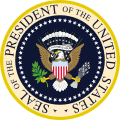Politicians
On January 19, Trump tweeted, "Not looking good for our great Military or Safety & Security on the very dangerous Southern Border. Dems want a Shutdown in order to help diminish the great success of the Tax Cuts, and what they are doing for our booming economy." [44]
In a statement, the White House blamed the shutdown on Senate Democrats and said that it would not negotiate with the Democrats on immigration. [45] The President's planned trip to Mar-a-Lago in Florida was postponed hours prior to the shutdown. [46]
Referencing his meeting with Trump, Senate Minority Leader Chuck Schumer said in a statement, "We discussed all of the major outstanding issues, we made some progress, but we still have a good number of disagreements. The discussions will continue." [47]
As the deadline for the 2018 funding approached, commentators pointed out Donald Trump's previous statements regarding shutdowns. In May 2017, Trump said that "our country needs a 'good shutdown'". [48] Back in 2013 during the Obama presidency, Trump, when asked who should be "fired" if there is a government shut down answered, "if you say who gets fired it always has to be the top (...) problems start from the top and they have to get solved from the top and the president’s the leader (...) when they talk about the government shutdown, they’re going to be talking about the president of the United States, who the president was at that time", and that in a shutdown, "the pressure" was on the president. [48] [49]
On January 21, Trump tweeted, "If stalemate continues, Republicans should go to 51% (Nuclear Option) and vote on real, long term budget, no C.R.'s!" [50] However, a representative for McConnell said the majority leader was opposed to using the nuclear option. [51] Republican Senator Susan Collins said that a group of more than twenty moderates will present ideas for resolving the shutdown of the federal government to the Senate's leadership. [52]
In a speech to US servicemembers at a military facility near the Jordan–Syria border, Vice President Mike Pence said that immigration talks between lawmakers and the White House couldn't proceed until the government reopens. [53] [54] Republican Senator Lindsey Graham criticized White House policy advisor Stephen Miller, saying negotiations were going nowhere as long as he was in charge of negotiating immigration. [55]
On February 6, 2018, as Congress continued to prepare another continuing resolution for a temporary budget, President Trump declared that if American immigration laws were not tightened, "We'll do a shutdown and it's worth it for our country. I'd love to see a shutdown if we don't get this stuff taken care of." [56]
During the January 2018 shutdown, Democratic and Republican officials offered up competing narratives over where to lay blame for the Senate's inability to strike an agreement on government funding, creating the competing #TrumpShutdown and #SchumerShutdown hashtags. [57] Trump used the hashtag #DemocratShutdown to counter #TrumpShutdown. [58] By the afternoon of January 20, #TrumpShutdown had been used some 2.6 million times on Twitter, Facebook, and Instagram; while the hashtag #SchumerShutdown was mentioned 1.3 million times during the same period. Other existing hashtags, such as #GOPShutdown and #DemShutdown, were mentioned 236,000 and 107,000 times respectively. [59] The Alliance for Securing Democracy said the hashtag #SchumerShutdown was the top trending hashtag being promoted by Russian bots and trolls on Twitter on the night of January 21. [60]







